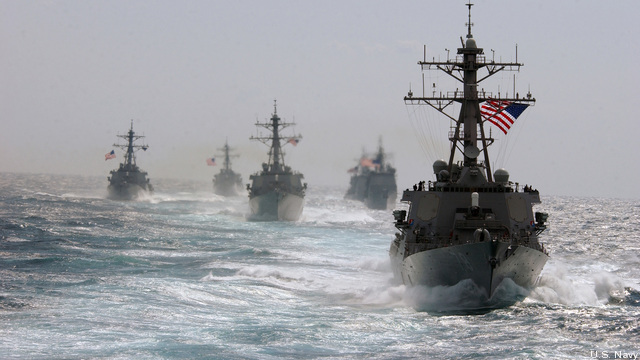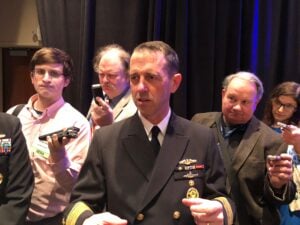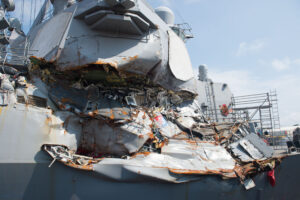
Aegis cruisers and destroyers.
UPDATED: Adds CNO Vision CRYSTAL CITY: Despite collisions this summer that killed 17 sailors and called into question basic seamanship skills, the Navy is undergoing a ‘renaissance’ in high-end warfighting capabilities, the commander of Naval Surface Forces says. New weapons, improved training, and a growing cadre of surface warfare specialists — veritable “Jedis” — are making the fleet more lethal more quickly than he’d expected, Vice Adm. Thomas Rowden told reporters ahead of the Surface Navy Association conference here.

Vice Adm. Tom Rowden
“I see it every day on the deckplates: the enthusiasm, the tactical innovation, all the things you want to see from an eager, lethal, young set of warfighting Jedis,” formally known as Warfare Tactics Instructors, Rowden said. Naval aviation has had a WTI (Weapons and Tactics Instructor) corps for years — the program made famous in the movie Top Gun — but the surface fleet didn’t have them until 2013. The 2015 establishment of the Naval Surface & Mine Warfighting Development Center (SMWDC) centralized and expanded the training programs, which run 13 to 19 weeks and admit only the top 25 percent of officers. Today there are almost 200 graduates in sub-specialties ranging from air and missile defense to anti-submarine warfare to amphibious operations.
UPDATE The Chief of Naval Operations personally singled out the commander of the Surface & Mine Warfighting Development Center during his speech to the Surface Navy conference. “John Wade,” Adm. John Richardson said, “your Weapons Tactics Instructors have made a huge difference at sea… showing people what that standard of excellence looks like….. You have eyes on target at sea, bringing (lessons) back.”

Adm. John Richardson, Chief of Naval Operations, is mobbed by reporters at the 2018 Surface Navy Association conference.
Those WTIs have spread across the fleet, Rowden said, helping to change “the way we think about the development of warfighting tactics…to ensure that we’re getting after not only the basic blocking and tackling of getting ships to sea but also… executing that high-end warfight.”
Last year also saw the introduction of new anti-ship weapons, an area where the US had fallen badly behind Russia, China, and their customers around the world. Relatively modest and affordable modifications turned the long-range Tomahawk, designed to hit static targets on land, and the supersonic SM-6, designed to kill aircraft and cruise missiles, into ship-killers, Rowden noted. The Littoral Combat Ship USS Coronado test-fired an off-the-shelf anti-ship missile, the Harpoon, a step towards upgunning the much-criticized LCS. The Navy also conducted a key shore test of a new design, the Long-Range Anti-Ship Missile (LRASM). Finally, the fleet also successfully tested the latest iteration, Baseline 9, of its Aegis air and missile defense system,

The Littoral Combat Ship USS Coronado launches a Harpoon anti-ship missile during a test off Guam.
Having more types of missiles, with more range, on more ships serves the Navy’s concept of Distributed Lethality. Rolled out at the Surface Navy Association conference two years ago and championed by Rowden, Distributed Lethality boils down to “if it floats, it fights.” The idea is multiply the enemy’s problems by putting offensive armament on as many US ships as possible, even amphibious transports and auxiliaries that the enemy could previously ignore, and dispersing all of them over vast distances to avoid retaliation, while still coordinating their strikes.

A Tomahawk cruise missile hits a moving maritime target Jan. 2015 after being launched from the USS Kidd (DDG 100) near San Nicolas Island in California.
Wargaming since 2015 has shown “significant (and) quantifiable operational benefits” to implementing Distributed Lethality, Rowden told the Surface Navy conference. The concept’s emphasis on fighting near-peer fleets was also endorsed by Adm. Richardson, then newly named Chief of Naval Operations, in his 2016 Design for Maintaining Maritime Superiority.
Now the Navy is finalizing the next evolution of Distributed Lethality, called Distributed Maritime Operations. The new, wider concept addresses not just missiles and ships but the complex command-and-control network required to coordinate them — now being called the Fleet Tactical Grid — and the invisible battle of sensors and jammers — now called Electronic Maneuver Warfare, Rowden told the conference. DMO won’t be rolled out at this week’s conference but is “soon to be promulgated,” the admiral wrote recently in Proceedings.
UPDATE The Navy’s new North Star is winning a major naval battle against an advanced adversary (i.e. China or Russia, a focus that borders on “obsession,” CNO Richardson told the conference. “First there’s clearly an intense focus on winning,” he said. “This focus for winning leaders, winning commanders, nears obsession.”
“Today’s COs must be prepared for winning in a great power competition, war at sea. They must be preparing their teams on the bridge, in combat, in engineering, at their guns, to win in combat,” Richardson continued. “They must be ready and confident to take their teams into combat against a competent and advanced enemy and win — to sail away with their crews, leaving the enemy out of action, slipping under the waves.”

Damage to the destroyer USS Fitzgerald after its collision with a merchant ship.
“If you’re a commander and you don’t feel that in your gut, if you’re not a little nervous about that, you’re not thinking hard enough,” the CNO said.
But, I asked the CNO afterward, how can the fleet promise to master high-end warfare when 2017’s accidents reveal failures of basic seamanship? The Navy’s working on all elements of seapower, RIchardson replied:
- Growing the fleet, not only by building new ships but also by extending the service lives of old ones;
- Modernizing the ships we have, especially by “network[ing] them together more effectively”; and
- Improving the people who bring the ships to life.
UPDATE ENDS
All these fearsome future capabilities “must be built on a foundation of professionalism and competence,” as Rowden wrote in Proceedings. The two are inseparable, he told reporters: “The ongoing renaissance and increasing the tactical warfighting readiness of our ships (and) the blocking and tackling, I do not in any way see those as mutually exclusive. We’re talking about building basic foundational capability.”
Repairing the foundation starts with the various reviews of last summer’s accidents. 20 percent of the Comprehensive Review’s 58 recommendations have been fully implemented to date, Rowden said. ” Let me be clear, the recommendations are not simply a list of to-do’s,” he told the conference. “This is a cultural shift for the surface force and Navy to be safer and more effective at sea, and we’re all in.”
Ultimately, though, the sailors can’t fix this on their own. “They need help—and by help, they mean time,” Rowden said. “Time to maintain their gear, time to refresh their basic individual and team skills, and time to unwind. Time will only come from one of two things, or a combination of them: more ships, and fewer obligations. It is hard to see things any other way.”
Edited Jan. 16 to clarify difference in title between Weapons & Tactics Instructors (naval aviation) and Warfare Tactics Instructors (surface warfare).
Shipbuilder Austal USA names Michelle Kruger as new president
Kruger had been serving as interim president since former chief Rusty Murdaugh resigned last spring.



























